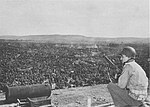Magnet Museum
German museum stubsMuseums in DortmundNorth Rhine-Westphalia building and structure stubsScience museums in Germany
The Magnet Museum (German: Magnetmuseum) is a private museum in Dortmund-Aplerbeck, owned by the company Tridelta. The exhibition provides an overview of historical and current applications of the permanent magnet in electrical engineering. In the museum, the use of permanent magnets in counters, speakers, telephones, switches, relays, clocks, measuring devices, small motors and generators are illuminated in the museum. One focus of the collection is the history of the magnet factory of Dortmund, which was established in the 1920s.
Excerpt from the Wikipedia article Magnet Museum (License: CC BY-SA 3.0, Authors).Magnet Museum
Edelstahlweg, Dortmund Aplerbeck (Aplerbeck)
Geographical coordinates (GPS) Address Nearby Places Show on map
Geographical coordinates (GPS)
| Latitude | Longitude |
|---|---|
| N 51.487777777778 ° | E 7.5544444444444 ° |
Address
Edelstahlweg 1a
44287 Dortmund, Aplerbeck (Aplerbeck)
North Rhine-Westphalia, Germany
Open on Google Maps










